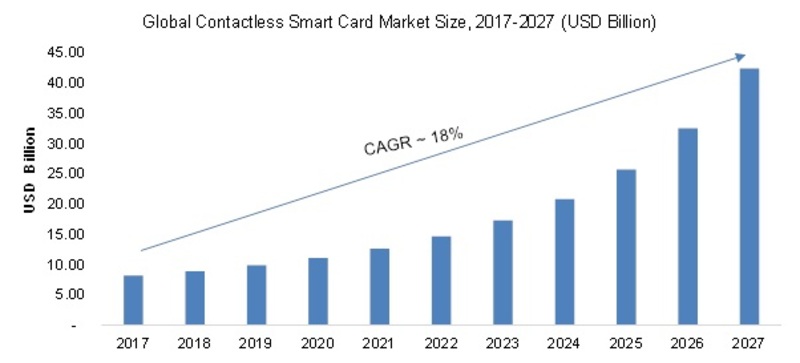Market Research Future takes into version on the impact of the novel COVID-19 pandemic on the global contactless smart card market 2020. It offers a clear assessment of the projected market fluctuations during the forecast period (2017–2027). Various factors are likely to impact the overall dynamics of the contactless smart card with a CAGR of 18% in the same forecasted period.
Few Well-Known Players in Contactless Smart Card Market are listed as:
Gemalto NV (Netherlands), ASK (France), Morpho (France), Giesecke & Devrient (Germany), Watchdata System (Singapore), Oberthur Technologies (France), CardLogix (U.S.), Advanced Card Systems (China).
Get Free Sample at:
https://www.marketresearchfuture.com/sample_request/1022
Outlook of Market:
Smart cards are pocket-sized cards that contain circuits and can be used for individual identification and authentication by organizations across diverse sectors. The scenario for growth in contactless smart card market will be driven by factors such as the elevated convenience of contactless smart cards and the augmented utilization of contactless smart cards by governments to address their rising need for security.
The expanding need for a tamper-resistant system will be the most influential driver for the growth of contactless smart cards market. Smart cards with magnetic strips have the competence to store financial information about end-users. Since contactless smart cards with PIN codes are difficult to corrupt with, they are progressively being adopted to encourage the safety of the card holder’s accounts. Such features have bolstered the market’s valuation highly, mainly in the novel coronavirus pandemic.
At present, people are adopting smart card technology while traveling to save time as well as increase convenience. The smart card technology eliminates the queue system while collecting tickets. Smart cards provide numerous benefits to commuters, which include a reduction in traveling time and improvements in service competence. They also facilitate governments and transport services to collect the travel data of commuters. Owing to the convenience of smart card payments, the usage of these can be extended to areas of the transport market such as washing, car parking, servicing, and fuelling. Such uses have been elevated among the sudden coronavirus disease outbreak happened worldwide.
Segmentation:
The global contactless smart card market has been segmented over the segments of type, application, and technology.
In terms of the type segment, the market is further classified into proximity card & CPU/MPU cards.
In terms of the application segment, the market is further classified into government, BFSI, healthcare, transportation, retail, defense, and loyalty, and more like these.
In terms of the technology segment, it is further classified into microprocessor smart card, smart memory card, smartcard integrated circuits, and others.
Regional Outlook:
Geographically, Asia Pacific leads the global contactless smart card market. The brisk digitization across industries of healthcare, retail, BFSI, and government has promoted consumers to adopt the products. Promising business models in this region, incorporating IoT, aim to employ these cards for payment processes, subsequently fuelling the regional industry expansion.
China has been one of the pioneers in phasing out checks and introducing contactless payments, leading to the overture of digital cards. The study finds that in November 2019, Alipay, China’s leading payment platform, served more than 1.2 billion customers. China’s ID cards attribute an embedded chip and digital encryption that contains personal information such as an individual’s full name in the Chinese gender, characters, date of birth, ethnicity, identification number, domicile, and a color photo.
Europe occupies the second-largest global contactless smart card market.
Table of Content:
1 Executive Summary
.
.
.
5 Industry Overview of Global Contactless Smart Card Market
5.1 Introduction
5.2 Growth Drivers
5.3 Impact Analysis
5.4 Market Challenges
6 Market Trends
6.1 Introduction
6.2 Growth Trends
6.3 Impact Analysis
Continued………..
List of Table:
Table 1 Global Contactless Smart Card Market: By Region, 2017-2023
Table 2 North America Contactless Smart Card Market: By Country, 2017-2023
Table 3 Europe Contactless Smart Card Market: By Country, 2017-2023
Table 4 Asia-Pacific Contactless Smart Card Market: By Country, 2017-2023
Table 5 Middle East & Africa Contactless Smart Card Market: By Country, 2017-2023
Continued…………
Browse More Details on Report at:
https://www.marketresearchfuture.com/reports/contactless-smart-card-market-1022
About Market Research Future:
At Market Research Future (MRFR), we enable our customers to unravel the complexity of various industries through our Cooked Research Report (CRR), Half-Cooked Research Reports (HCRR), Raw Research Reports (3R), Continuous-Feed Research (CFR), and Market Research & Consulting Services.
MRFR team have supreme objective to provide the optimum quality market research and intelligence services to our clients.
Media Contact
Company Name: Market Research Future
Contact Person: Abhishek Sawant
Email: Send Email
Phone: +1 646 845 9312
Address:Market Research Future Office No. 528, Amanora Chambers Magarpatta Road, Hadapsar
City: Pune
State: Maharashtra
Country: India
Website: https://www.marketresearchfuture.com/reports/contactless-smart-card-market-1022

